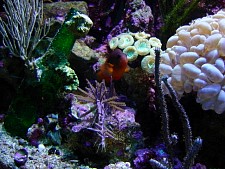 |
This month we would like to bring you one of the oldest hobbyist reef tanks in existence. Many of you may have seen Paul's thread in the Reef Discussion forum, as it has been a popular staple there for quite a few years. Reefkeeping Magazine asked Paul to write an article explaining his personal success over the 40+ years of the life of his tank. As these are the views and practices of one aquarist, your experiences may vary. Paul has had success with his practices and, though these experiences and practices may not be the "norm," they have worked quite well for him over his many years of reefkeeping.
I have been asked a few times to write an article about my experiences in this hobby, and I am always at a loss as to where to start. Not because my tank is better or healthier than any one else’s tank, but because it is so different. Some will say odd, others will say my practices are weird. [Editor’s note: and many of us have found inspiration and admiration for Paul and his long-lived reef and fish!]
The reason my tank is rather unique is because my methods were developed and evolved at the beginning of the saltwater hobby, and many years before the Internet became a major factor. Today, many tanks look similar because almost everyone gets their information from the Internet. This is a hobby, a pastime, and by definition, only important to us hobbyists. There are no degrees, no fellowships, no doctorates to be awarded for this hobby, so experts are basically self-proclaimed. This is the reason there are so many different ways to start and manage a tank. It is also an expensive hobby which, unfortunately after a few years, forces many people to sell everything and go on to other endeavors due to frustration.
To me, my aquarium is not “just” a hobby. I have had a tank of some kind every day of my life from the 1950s, and it is an integral part of who I am. As far back as I can trace, my ancestors were fisherman in
Originally posted by Paul B:
“I took out the UG filter last year for a cleaning. I do that every 25 years whether it needs it or not.”
My first failure was when I tried a deep sand bed. I used standard beach sand from a
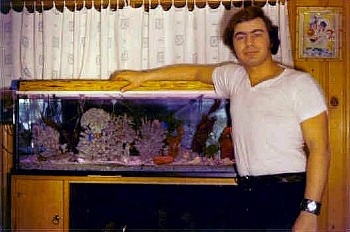 |
That undergravel filter was my second mistake. Not that an undergravel filter is detrimental in saltwater, but the way I was using it was not quite right. After about a year, the undergravel filter clogged, effectively stopping the nitrification process and causing undue stress on the fish. Ich became rampant, and the gravel was filthy. I had to use a diatom filter - a canister filter with a very fine filtering media. This filtering necessitated the removal of all the coral skeletons for cleaning (there was no live rock available in the trade at that time. This is the reason almost no one uses an undergravel filter anymore. Before the advent of undergravel filters, though, saltwater fish could not be successfully kept in captivity by hobbyists.
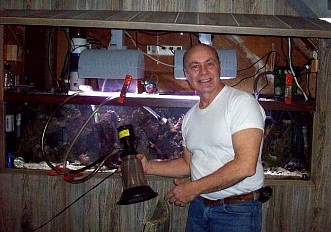 |
I have also learned a few simple, but important, things as to how to get fish from mediocre health into excellent health. Much of this I learned from observing fish in the sea. If you have ever been diving, you will notice that wild fish almost always look better than captive fish. I think I've learned why this is. In the sea, fish eat mostly fish - not fish fillets, but whole fish. On any healthy reef, the portions near the base of the rocks are teeming with fry. Fish on the reef do not immediately eat all of these fry, as they would in a tank, because they are free for the taking at any time. Fry are not particularly hard to catch, so the larger fish do not have to work very hard for their dinner.
I believe that the reason wild fish are so healthy is because the diet of many of them consists of tiny fish, which consist of about a 20 percent oil as well as a healthy amount of calcium. All fish have a liver, which in a fish such as a shark, can take up almost a quarter of the animal’s weight. Almost all of that liver is fish oil. So a hundred pound shark can contain almost 25lbs. of oil.
As humans, we cannot use too much fish oil, as it becomes toxic to us in even fairly small doses. However, we do need some of it. Many fish, on the other hand, are used to getting almost a fifth of their diet as oil. As land based aquarists, we are often forced to feed our fish what is available in stores. Unfortunately, that usually consists of items such as squid, brine shrimp, clams, fish fillets, lettuce, beef heart, blood worms (not really worms but beetle larvae), mosquito larvae and angel formula. Most of these foods, as sold, are typically not available to reef fish in the sea, and none of them contain nearly enough Omega-3 fish oils. A variety of these commonly available foods offered to our fish will allow them to live long lives. But do we want our fish just to live, or do we want them to thrive, reproduce and be resistant to diseases - even parasites?
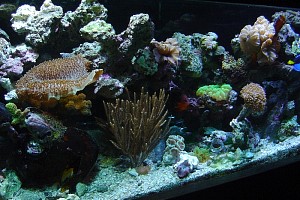 |
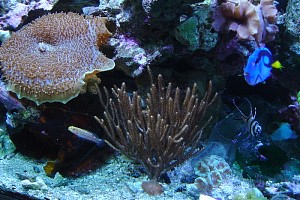 |
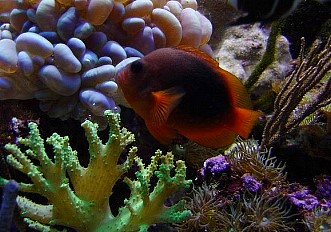 |
| 15 year old fire clown with 15 year old bubble coral. |
I have found a supply of tiny baby mackerel in Asian food stores. They are dried, and although my fish eat them, they are not crazy about their texture, which is similar to wood. Another method is to use flake food. Just put a drop of fish oil (available in any health food store, supermarket or pharmacy) into a container of water and float the flakes on top of it. The flakes will absorb some of this oil and can then be fed to the fish. This method, however, will leave a colorful oil slick on the water surface water, and will cause the skimmer to stop producing foam for about an hour.
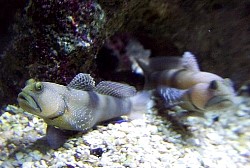 |
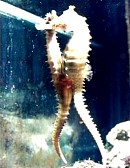 |
| Watchman gobies preparing to spawn (left) and seahorses begin egg transfer (right). | |
My tank contains numerous smaller fish, such as gobies and pipefish, so I hatch and feed live brine shrimp every day. Without this food source, I would not be able to keep these animals. Blue-striped pipefish have been spawning for me for quite a few years, as have many of the gobies. Newly hatched brine shrimp are an excellent food as their yolk sac is full of oil and other nutrients. Sadly, adult brine shrimp lack almost everything, nutrition-wise, that is needed for our fish.
I also have some different opinions about algae. The word "algae" strikes fear in many novice aquarists hearts, and volumes have been written on how to cure a tank of nuisance algae. I submit that algae cannot be cured because it is not a disease. I almost always have some type of algae growing, and I only fear it if it dies. Algae grow on every healthy reef on earth. If it did not, what would urchins, slugs, tangs, snails and various blennies eat? Those animals are there because algae is there. One typically does not see much algae on a reef because of the hordes of these animals, many of which appear only at night.
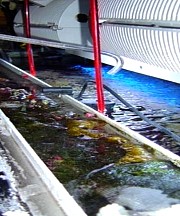 |
| Algae trough filter |
One of the most expensive items we buy to begin a tank is rock. Years ago, I would never have dreamed we would buy bottled water. And I never dreamed we would also purchase rock at a very high price. Live rock can cost thousands of dollars to fill even a medium tank. But again, I found another way. We have materials available to us that can be used to manufacture rocks very cheaply. And these are not just any rocks, but rocks that look better and reduce nitrates better than “real” rocks from the sea.
I collected almost all of my rocks in the tropics because, well, it was free. Since we are not allowed to do that anymore, we can only buy it. I have found that I like the rocks I built better than the rocks I have collected. Rocks are typically collected in shallow water and thrown up on barges. They are then sorted in bins and shipped all over the world to be sold to aquarists. This collecting and shipping has a tendency to break any protuberances off of the rock, and we are left with roundish, boring sorts of rocks.
 |
| Which is the real and which is the “fake” rock? |
I build rocks from cement, but the rocks I build have a PVC pipe “backbone.” Thus, they are hollow. The PVC, after being drilled in many places for water entry, is heated and bent in any shape that I think would work in a display. Plastic window screen is then wrapped on and glued. Lastly, cement is laid on the screen in multiple coats. It takes five or six coatings, however, before it is completed. The hollow backbone of this “rock” harbors anaerobic bacteria that is beneficial in converting nitrate to atmospheric nitrogen. After a few weeks, you would not be able to tell which pieces come from the sea and which came from Home Depot. In my own tank, I cannot even be sure with some of the older pieces, but I can build rocks of any length or thickness I desire with places to hold corals or harbor fish eggs. And, this rock is built for only a few dollars! The longer, thinner rock is usually not available commercially, but it creates a very unusual display - very different from anything you will see from store-bought or even rock you hand harvest yourself.
Ich, aaaaaaaaahhhhhg!! Yes, that’s the sound some people make when they see it. Of course, I believe fish in breeding condition will hardly be afflicted with it. But it is extremely easy to cure, and I do not know why so much ink is wasted on teaching us how to cure it. We now have liquid copper that will cure it in a few days. In my earlier days we once used pennies, but I won’t go into that.
There are rumors that copper affects a fish's liver. I don’t really know, but before there were captive reefs, our fish were not very healthy and everything had ich. We would always keep copper in the tank. I had hippo tangs live ten years, and, for many of those years, the fish was swimming in copper-treated water. Aquarists now like to use hyposalinity treatments. Yes, that works, but ich can kill a fish in just a couple of days - hyposalinity techniques takes weeks. In the end, the ich usually wins. This is just my opinion.
Should we quarantine? This is where I am likely to get myself in trouble! There are two schools of thought on this, but since this article is mainly about my tank and my experiences/practices, I will report on what I personally do. I do not think of my tank as a showpiece just to be admired by my house guests. Although, I do love it when people gaze at it and ask, “Why do you have bottles in there?” My tank is, and always has been, an experiment. I would rather have a brown, plain, nondescript looking goby spawn than have a beautiful angelfish just swimming around in circles.
I live near the sea and am fortunate enough to be able to take advantage of much of the flora and fauna there. I collect my own water, amphipods, seaweeds, bacteria, rocks, worms, shrimp, barnacles, etc. It would be impossible for me to quarantine all of these things. I'll also add that if you do not have my tank, along with my years of experience,, you should probably quarantine.
Also, if your fish are not in breeding condition, they are much more susceptible to parasitic infections such as ich. Being in breeding condition does not guarantee that fish will not get ich, it just gives them a much better chance of avoiding it.
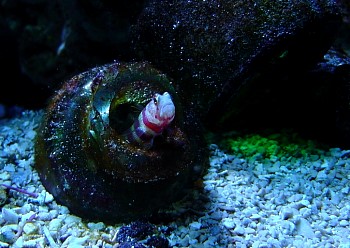 |
All newcomers to this hobby should quarantine everything, even rocks. If I started a new tank tomorrow with new water and gravel, I would definitely have to quarantine. It takes time, sometimes years, for a tank to become mature and fully cycled. Being cycled does not mean that you read no nitrites on your $5.00 test kit. I believe a tank continually cycles with regard to its bioload.
There is one more non-typical thing that I do that some may consider either risky or just useless. I mentioned above that I add bacteria from the sea to my tank. I feel bacteria are the most overlooked aspect of this hobby, and are vital to a healthy, long-lived tank. Bacteria cover everything in our tanks, but are they the correct bacteria for our purposes? Probably not. Bacteria enter our tanks in a number of various ways. Every time we put our hands into the water, we add bacteria. When we add fish, corals, rock or food, we add bacteria. The bacteria on the rocks and fish were at one time in the sea and “some” of those bacteria are the correct bacteria for our needs. But eventually, that bacteria will stop reproducing and will be outnumbered or outcompeted by other bacteria that may not be dangerous but do not necessarily help complete the nitrogen cycle. Why do so many people change so much water and still have nitrates? If we had the correct numbers and types of bacteria, we would never have to change water just to lower nitrates; the bacteria do that for us for free. I have found that by adding bacteria from the sea a few times a year, my reef stays healthy. I have no scientific data on this theory, but I do have a 40-year-old tank with an undergravel filter and no nitrates.